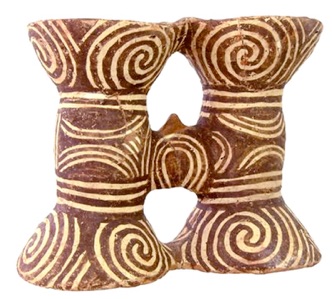Trypillian Symbols


If you examine Trypillian pottery, you will see certain motifs appearing over and over: spirals, serpents, bezkonechnyky1, waves, circles and triangles. There are parallel lines, dots, hatch marks, and lattice-like patterns. Perhaps these symbols were decorative, or perhaps they had important ritual meanings. It is hard to say.
In 2002, Palmarchuk and Andriyevskyi, in their book «Зорі Трипілля» (The Stars of Trypillia), proposed a Trypillian hieroglyphic alphabet, similar in nature, they said, to that possessed by the Egyptian, Sumerians, Cretans or Maya. They collected 206 glyphs, and assigned them meanings. On what they based these meanings, I have no idea, and their book does not say. Perhaps they compared their glyphs to more modern symbols, or perhaps it was extrapolation, or even flights of fancy. But they published their hieroglyphic dictionary, noting that, altogether, there were probably a thousand or more symbols, as color, orientation and context might change their meanings.
After all, Egyptian hieroglyphs emerged from the preliterate artistic traditions of Egypt. For example, symbols on Gerzean pottery from circa 4000 BC resemble hieroglyphic writing. And the development of Sumerian cuneiform writing was an evolution of an earlier Mesopotamian accounting system that had been used for five thousand years before. Clay tokens had been used for some form of record-keeping in Mesopotamia since as early as 8,000 BC. Cuneiform documents were written on clay tablets, by means of a reed stylus. The antiquity of Trypillian civilization does not preclude their having developed a writing system.
The claims made by Palmarchuk and Andriyevskyi are similar to those made by the proponents of Vinca or Old European Script, and based on a similar source (pottery markings). Both posit European writing systems dating back to the 6th-4th centuries BCE.
On the following pages I have placed this set of symbols in an album, with their “meanings” in English and Ukrainian. I have retained Palmarchuk’s numbering system, although I don’t know if there is any significance to the numbers. I am including this information not because I think they have cracked the Trypillian code, but because the symbols are interesting in and of themselves, and their similarity to many modern symbols is striking.
__________
-
1. A bezkonechnyk (безкончник) is a never ending line, a meander.

Back to MAIN Pysanka home page.
Back to Pysanka Index.
Search my site with Google
Slavic Hieroglyphics


